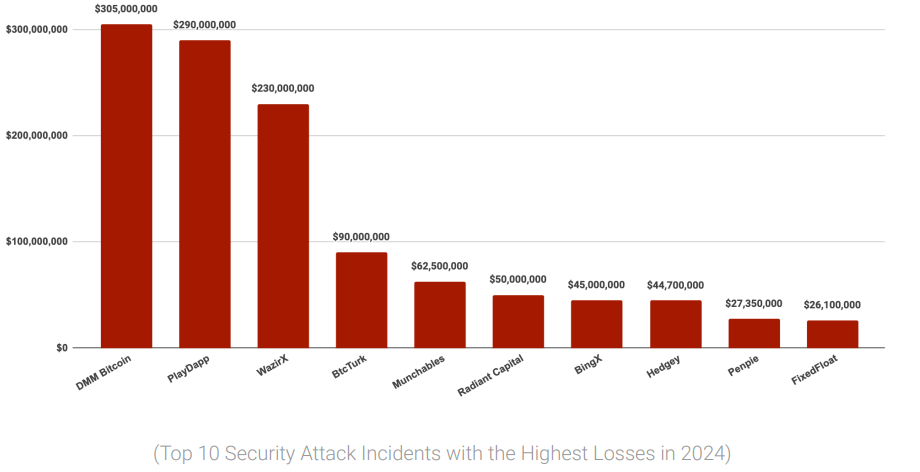Slowmist Reveals 2024’s Top 10 Crypto Security Incidents
- Slowmist highlights the top 10 major crypto security incidents of 2024, exposing vulnerabilities across platforms and exchanges.
- North Korean-linked groups played a significant role in some of 2024’s most critical cryptocurrency hacking incidents.
The year 2024 saw some of the most serious security breaches in crypto history. A recent Slowmist report points up weaknesses across projects, blockchain systems, and exchanges. With billions in damages overall, these events highlight the ongoing dangers in the quickly changing crypto space.

Top 10 Security Incidents in Crypto for 2024
1. DMM Bitcoin: Japan’s Third-Largest Crypto Exchange Hack
DMM Bitcoin, a Japanese crypto exchange, announced on May 31, 2024, the illegal 4,502.9 BTC transfer valued at around $330 million. Following Mt. Gox (2014) and Coincheck (2018), this hack of a crypto exchange ranked third in Japan’s history.
Authorities connected the hack to the TraderTraitor campaign, a North Korean-affiliated outfit well-known for social engineering methods. Unencrypted communication networks were compromised via a malicious Python script posted to a GitHub page, therefore allowing the theft.
2. PlayDapp: Phishing Attack Exposes PLA Token Vulnerability
On February 9, 2024, PlayDapp, a blockchain gaming platform, suffered a serious attack compromising the smart contract secret key of its PLA token.
Though exchange freezes help to offset more losses, hackers created over 1.79 billion PLA tokens. Emphasizing the need for email security, the compromise resulted from a phishing email including a modified remote-access tool.
3. WazirX: Interface Exploit Unveils Wallet Service Vulnerabilities
On July 18, 2024, Indian crypto exchange WazirX noticed dubious activity. Investigations found that hackers took advantage of differences in Liminal, a transaction-verifying tool’s interface. This highlighted weaknesses in wallet service providers since it resulted in losses of around $230 million.
4. BtcTurk: Hot Wallet Breach Highlights Cybersecurity Risks
Turkish exchange BtcTurk suffered a cyberattack compromising 10 cryptocurrencies’ holdings in its hot wallet on June 22, 2024. Reported losses in the transaction were $90 million. Crucially important, Binance froze $5.3 million of the pilfered funds, therefore reducing some damage.
5. Munchables: Internal Threats and an Unexpected Fund Recovery
On March 27, 2024, former developers caused the $62.5 million loss the Blast ecosystem project Munchables suffered. Fascinatingly, these people later returned $97 million to show the complexity of internal risks in blockchain companies.
6. Radiant Capital: Multisig Wallet Breach Linked to UNC4736
Following a fraudulent contract upgrade, Radiant Capital suspended activities on October 17, 2024. Attackers stole $50 million from three multisig wallets. Security company Mandiant connected the hack to another North Korean entity called UNC4736.
7. BingX: Hot Wallet Breach Tied to the Lazarus Group
With losses of $45 million, Singapore-based exchange BingX noted illegal access to a hot wallet on September 20, 2024. Examining the incident connected it to the notorious Lazarus Group, a North Korean hacker outfit, therefore revealing their worldwide influence.
8. Hedgey Finance: Validation Flaws Expose Critical Vulnerabilities
Insufficient input validation cost Hedgey Finance $44.7 million on April 19, 2024. Attackers made use of system weaknesses, therefore influencing Ethereum and Arbitrum’s operations. This episode emphasizes how important thorough code audits are.
9. Penpie: Flash Loan Exploit Reveals Market Assumption Flaws
Liquidity rewards project Penpie lost $27.35 million on September 4, 2024. Attackers used fraudulent contracts and flash loans to take advantage of Pendle Finance’s market development process by basing their assumptions wrong.
10. FixedFloat: External Vulnerabilities Lead to Multiple Breaches
FixedFloat on a crypto platform suffered several attacks in 2024. The first, on February 16, claimed 409 BTC and 1,728 ETH. Total damages from a follow-up attack on April 2 came to $29 million. The breaches highlight the threats posed by unresolved outside vulnerabilities.
These events expose recurrent themes: social engineering, phishing, insider risks, and poor system validation. Understanding these hazards and supporting improved security policies depend on the Slowmist report, which is a vital tool.
Stakeholders in the crypto space have to give strong defenses top priority in order to guard against ever more complex attacks.
Disclaimer: The content of this article solely reflects the author's opinion and does not represent the platform in any capacity. This article is not intended to serve as a reference for making investment decisions.
You may also like
Hackers are targeting Australia’s largest pension funds
Share link:In this post: Hackers targeted major Australian superannuation funds, stealing $500,000 from a few accounts and exposing personal data. Authorities and financial institutions are responding to the breach, urging members to check accounts and update passwords. Credential stuffing using stolen passwords is suspected in the attacks, prompting warnings to use unique logins and enable multifactor authentication.
Meta to end third-party fact-checking in U.S. on April 7
Share link:In this post: Meta will shut down its U.S. third-party fact-checking program on April 7, 2025, ending partnerships with groups like PolitiFact. It will be replaced by Community Notes, a system that lets users add context to posts without triggering penalties. Zuckerberg criticized the old system as biased and overly censorious, and said the change aims to support free speech. Meta is also relocating its moderation teams to Texas, a move some experts say is politically motivated.

Crypto Today: Altcoins Find New Buyers as Microsoft, Apple and Nvidia Lose $1 Trillion in 3 Days
Cardano Approaching First Death Cross: What’s Next for ADA Price?
